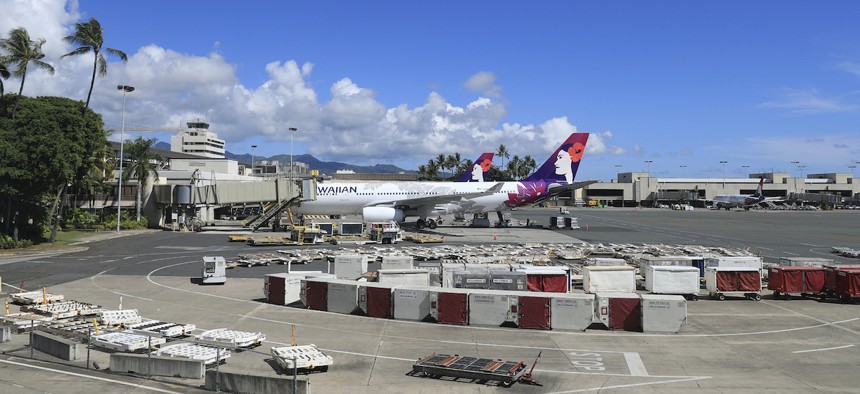Jobs Recovery Slows for States and Remains Uneven

An airplane is seen parked at a terminal at the the Daniel K. Inouye International Airport Thursday, Oct. 15, 2020, in Honolulu. Hawaii has suffered outsized job losses in its tourism sector as the pandemic halted travel to the islands. Associated Press
An analysis by Fitch Ratings found that job growth had slowed for most states as Covid-19 cases and hospitalizations surge across the country.
Nine states lost jobs in September as employment growth slows across the country amid rising Covid-19 cases and hospitalization rates, according to a new report from Fitch Ratings, a credit rating agency.
Unemployment rates increased in Alabama, Arizona, Georgia, Hawaii, Idaho, North Carolina, Texas and Utah, while Indiana also lost roughly 11,700 jobs, Bureau of Labor Statistics data show. But a majority of states saw growth, though the pace is decreasing, said Olu Sonola, a senior director for the agency.
“States by and large saw continued improvement in jobs recovery in September, although the pace has slowed since the summer,” Sonola said in a statement. “We expect the economic recovery to continue slowing this quarter.”
Nationwide, non-farm jobs improved to a median rate of 55% in September, up from 51% in August, according to the report. But the rate of recovery varies from state to state. New York, Alaska, Illinois, Nevada, New Jersey and Kentucky “all saw the steepest employment declines in the first three months of the pandemic,” and have seen slower recovery in recent months than other states, the report said.
Hawaii was first among states that lost jobs, a continued trend since March as the state's tourism and hospitality-based economy was particularly paralyzed by the pandemic. The state’s unemployment rate in September was 15.6%, the highest in the country, while Nevada, which also depends heavily on tourism, posted the second-highest at 12.6%.
Officials in Hawaii last month began attempting to reinvigorate the tourism economy by eliminating a mandatory two-week quarantine period for visitors as long as they can furnish a negative coronavirus test result, even as cases are rising in some parts of the state. The initiative has caused tension between some residents and travelers.
In its analysis, Fitch adjusted unemployment rates to include people who've dropped out of the workforce—perhaps because they lack child care or have safety concerns—but aren't officially categorized as out of work, finding that when they are included eight states have unemployment rates as high as Nevada's.
Jobs are coming back faster in some states. In Massachusetts, the unemployment rate fell to 9.6% in September, down from 11.4% in August, thanks largely to “a notable uptick in hiring in the education and health services sector, which drives a large portion of their economy,” Sonola said. But the state was still one of eight that had recovered less than half the jobs lost during the height of the pandemic, along with Alaska, California, Delaware, Hawaii, Louisiana, New York and Oregon.
Despite the disparities, most states are well-positioned to handle uncertain revenue streams in the coming months, the report said, as long as the economy continues on a general path of recovery. Another decline, added to existing revenue declines from prolonged shutdowns, could erode states’ abilities to close funding gaps—a scenario that could hinge largely on how the number of coronavirus cases increases or falls, the report concluded.
“High unemployment negatively affects income and sales tax revenues, squeezing state budgets and slowing economic recovery,” analysts wrote. “Covid-19 cases and hospitalization rates are increasing in almost all states, which will weigh on the pace of recoveries.”
Kate Elizabeth Queram is a staff correspondent for Route Fifty and is based in Washington, D.C.
NEXT STORY: West Virginians Were Promised an Economic Revival. It Hasn’t Happened Yet.





